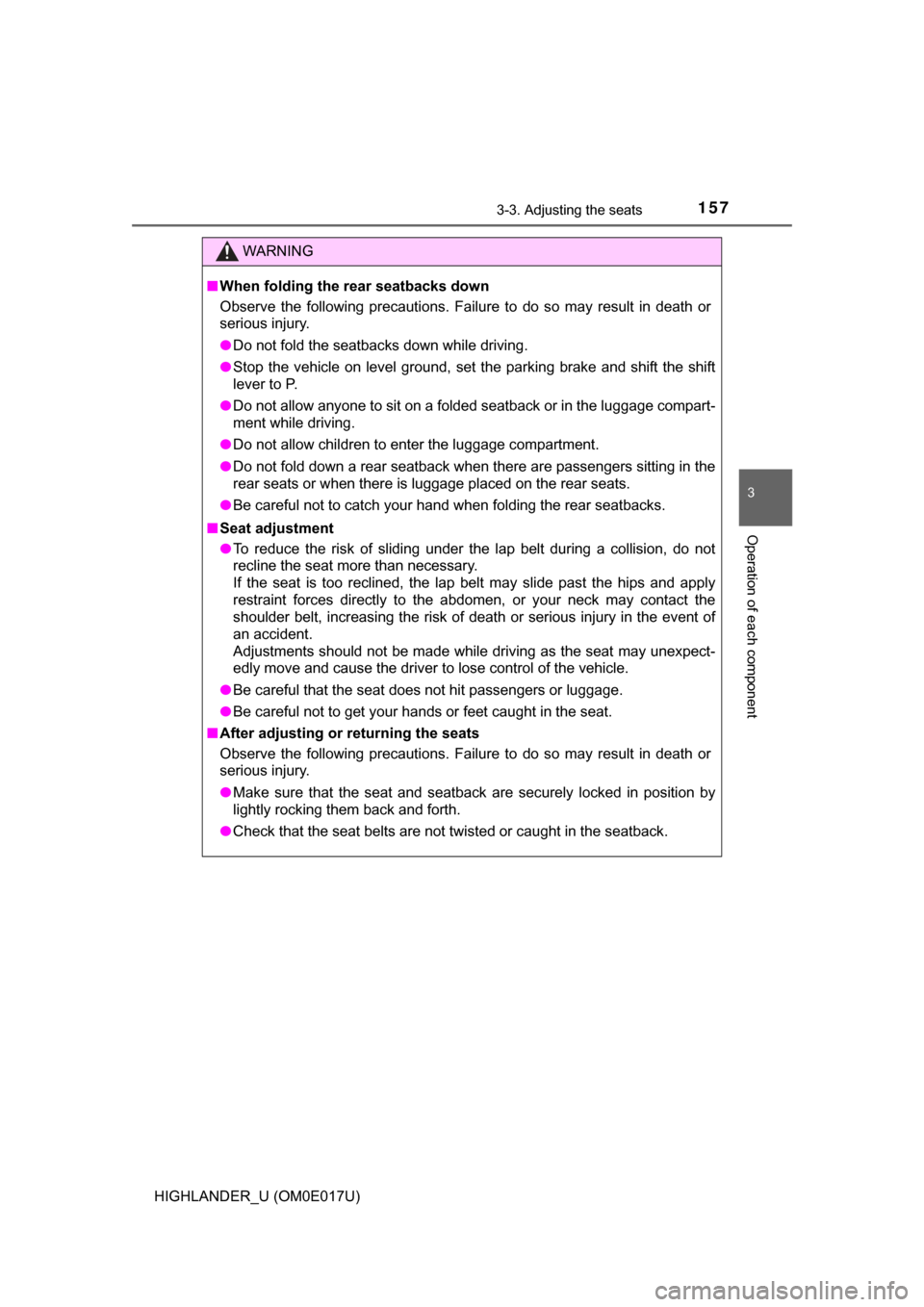Page 153 of 732
1533-3. Adjusting the seats
3
Operation of each component
HIGHLANDER_U (OM0E017U)■
Before folding down the second seats
Stow the armrest. ( →P. 478)
With a side table: Stow the side table. ( →P. 480)
Stow the second seat belt buckles.
Pass the outer seat belts
through the seat belt hangers
and secure the seat belt
plates.
This prevents the shoulder belts
from being damaged.
Make sure that the seat belts
are removed from the hangers
before using them.
Lower the head restraints to the lowest position. ( →P. 162)
Folding down the second seats
1
2
3
Without a side tableWith a side table
4
5
Page 155 of 732
1553-3. Adjusting the seats
3
Operation of each component
HIGHLANDER_U (OM0E017U)■
Returning the second seats
Lift up the seatbacks until they
lock.
■Before folding down the third seats
Stow the third seat belt buck-
les.
Pass the outer seat belts
through the seat belt hangers
and secure the seat belt
plates.
This prevents the shoulder belts
from being damaged.
Make sure that the seat belts
are removed from the hangers
before using them.
Lower the head restraints to the lowest position. ( →P. 162)
Folding down the third seats
1
2
3
Page 157 of 732

1573-3. Adjusting the seats
3
Operation of each component
HIGHLANDER_U (OM0E017U)
WARNING
■When folding the rear seatbacks down
Observe the following precautions. Failure to do so may result in death or
serious injury.
● Do not fold the seatbacks down while driving.
● Stop the vehicle on level ground, set the parking brake and shift the shift
lever to P.
● Do not allow anyone to sit on a folded seatback or in the luggage compart-
ment while driving.
● Do not allow children to enter the luggage compartment.
● Do not fold down a rear seatback when there are passengers sitting in the
rear seats or when there is luggage placed on the rear seats.
● Be careful not to catch your hand when folding the rear seatbacks.
■ Seat adjustment
● To reduce the risk of sliding under the lap belt during a collision, do not
recline the seat more than necessary.
If the seat is too reclined, the lap belt may slide past the hips and apply
restraint forces directly to the abdomen, or your neck may contact the
shoulder belt, increasing the risk of death or serious injury in the event of
an accident.
Adjustments should not be made while driving as the seat may unexpect-
edly move and cause the driver to lose control of the vehicle.
● Be careful that the seat does not hit passengers or luggage.
● Be careful not to get your hands or feet caught in the seat.
■ After adjusting or returning the seats
Observe the following precautions. Failure to do so may result in death or
serious injury.
● Make sure that the seat and seatback are securely locked in position by
lightly rocking them back and forth.
● Check that the seat belts are not twisted or caught in the seatback.
Page 197 of 732

1974-1. Before driving
4
Driving
HIGHLANDER_U (OM0E017U)
WARNING
■Things that must not be carried in the luggage compartment
The following things may cause a fire if loaded in the luggage compart-
ment:
●Receptacles containing gasoline
●Aerosol cans
■Storage precautions
Observe the following precautions.
Failure to do so may prevent the pedals from being depressed properly,
may block the driver’s vision, or may result in items hitting the driver or
passengers, possibly causing an accident.
●Stow cargo and luggage in the luggage compartment whenever possi-
ble.
●Do not stack cargo and luggage in the luggage compartment higher
than the seatbacks.
●Do not place cargo or luggage in or on the following locations.
• At the feet of the driver
• On the front passenger or rear seats (when stacking items)
• On the instrument panel
• On the dashboard
●Secure all items in the occupant compartment.
●When you fold down the rear seats, long items should not be placed
directly behind the front seats.
●Never allow anyone to ride in the luggage compartment. It is not
designed for passengers. They should ride in their seats with their seat
belts properly fastened.
Page 299 of 732

2994-5. Using the driving support systems
4
Driving
HIGHLANDER_U (OM0E017U)
■Operating conditions
●The Stop & Start system is operational when all of the following conditions
are met:
• The brake pedal is being depressed firmly.
• The engine is adequately warmed up.
• The outside temperature is 23°F (-5°C) or higher.
• The shift lever is in D.
• is off.
• The hood is closed.
• The driver's seat belt is fastened.
• The driver's door is closed.
• The accelerator pedal is not being depressed.
● In the following situations the engine may not be stopped by the Stop & Start
system. This is not a malfunction of the Stop & Start system.
• The air conditioning system is being used when the ambient temperature
is high or low.
• The battery is not sufficiently charged, such as if the vehicle has been
parked for a long time and the battery charge has decreased, the electric
load is large, the battery temperature is excessively low or the battery has
deteriorated, or is undergoing a periodic recharge.
• The brake booster vacuum is low.
• The vehicle is stopped on a steep incline.
• The steering wheel is being operated.
• Due to traffic or other circumstances the vehicle is being stopped repeat- edly.
• The vehicle is being driven in a high altitude area.
• Engine coolant temperature or transmission fluid temperature is extremely low or high.
• The battery fluid temperature is extremely low or high.
• For a while after the battery terminals have been disconnected and reconnected.
• For a while after the battery replacement.
• Power mode or snow mode is selected.
Page 300 of 732

3004-5. Using the driving support systems
HIGHLANDER_U (OM0E017U)●
In the following situations, the engine will restart automatically if the engine
is stopped by the Stop & Start system. (To enable stopping of the engine by
the Stop & Start system, drive the vehicle.)
• The air conditioning system is turned on.
• is turned on.
• The steering wheel is operated.
• The shift lever is shifted to a position other than D.
• The driver's seat belt is unfastened.
• The driver's door is opened.
• The accelerator pedal is depressed.
• The Stop & Start cancel switch is pressed.
• The vehicle starts to roll on an incline.
● In the following situations, the engine may restart automatically if the engine
is stopped by the Stop & Start system. (To enable stopping of the engine by
the Stop & Start system, drive the vehicle.)
• The brake pedal is pumped or strongly depressed.
• The air conditioning system is being used.
• The battery is not sufficiently charged.
■ Hood
●If the hood is opened while the engine is stopped by the Stop & Start sys-
tem, the engine will stall and will not be able to be restarted by the automatic
engine start function. In this case, restart the engine using the normal
engine starting procedure. ( →P. 218, 221)
● Even if the hood is closed after the engine is started with the hood open, the
Stop & Start system will not operate. Close the hood, turn the engine switch
off, wait 30 seconds or more, and then start the engine.
■ When to use the Stop & Start system
●When the system cannot operate, is canceled, or is malfunctioning, warning
messages and a warning buzzer are used to inform the driver. ( →P. 303)
● Vehicles with a smart key system: If the engine switch is pressed when the
engine is stopped by the Stop & Start system, the engine will stall and will
not be able to be restarted by the automatic engine start function. In this
case, restart the engine using the normal engine starting procedure.
(→P. 218, 221)
● When the engine is restarted by the Stop & Start system, the power outlets
may be temporarily unusable, but this is not a malfunction.
● Installation and removal of electrical components and wireless devices may
affect the Stop & Start system. Contact your Toyota dealer for details.
Page 304 of 732
3044-5. Using the driving support systems
HIGHLANDER_U (OM0E017U)“Driver Seat Belt
Unbuckled”
The driver seat belt is not fastened.
“Stop & Start
Unavailable”
• The Stop & Start system is temporarily dis-
abled.
Operate the engine for a short while.
• The engine may have been started with the
hood open.
Close the hood, turn the engine switch off,
wait for 30 seconds or more, and then start
the engine.
“System Tempera-
ture Low”
The battery may be cold. Operating the engine for a short while allows
the system to recover due to the temperature
increase in the engine compartment.
“System Tempera-
ture High”
The battery may be extremely hot. If the engine compartment is allowed to cool
sufficiently, the system recovers.
“Non-Dedicated
Battery”
A non-dedicated battery for the Stop & Start
system may have been installed. The Stop & Start system does not operate.
Have the vehicle inspected by Toyota dealer.
MessageDetails
Page 305 of 732

3054-5. Using the driving support systems
4
Driving
HIGHLANDER_U (OM0E017U)●
When the engine automatically restarts while stopped by the Stop & Start
system
■ If “Stop & Start System Malfunction Visit Your Dealer” is displayed on
the multi-information display
The system may be malfunctioning. Have the vehicle inspected by Toyota
dealer.
■ If the Stop & Start cancel i ndicator continues to flash
The system may be malfunctioning. Have the vehicle inspected by Toyota
dealer.
MessageDetails
“For Climate Con-
trol”
• The air conditioning system has been turned on or is being used.
• has been turned on.
“For Brake System”
The brake pedal has been depressed further
or pumped. The system will be enabled after the engine
runs and the brake booster vacuum reaches a
predetermined level.
“Battery Charging”
The battery charge amount may be low. The engine is restarted to prioritize battery
charging. Operating the engine for a short
while allows the system to recover.
“Steering Wheel
Turned”
The steering wheel was operated.
“Driver Seat Belt
Unbuckled”
The driver seat belt has been unfastened.